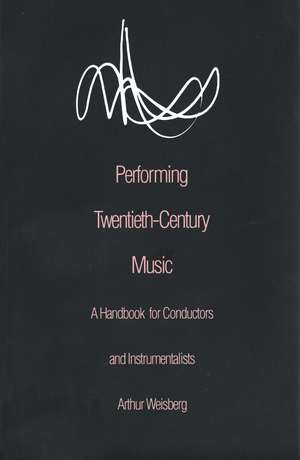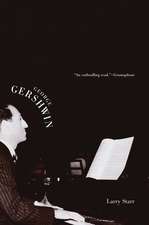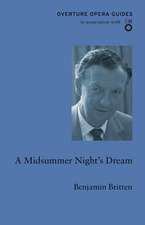Performing Twentieth-Century Music: A Handbook for Conductors and Instrumentalists
Autor Arthur Weisbergen Limba Engleză Paperback – 21 feb 1996
Even the most accomplished musicians are often defeated by the demands of the modern repertory. Yet until now, no practical manual has addressed the performance problems specific to twentieth-century music. This concise, straightforward handbook by the renowned conductor and instrumentalist Arthur Weisberg will guide performers and conductors in negotiating the diverse paths taken by composers in this century.
Most of the difficulties particular to modern music center around rhythm and counting. Performers must perfect the accurate, fluent reading of complex rhythms. Conductors must not only understand the rhythmic problems they encounter but also be able to teach the players how to perform them. Composers themselves need to know how best to notate their rhythmic ideas. Bearing these demands in mind, Weisberg clearly explains the new rhythmic complexities and provides exercises for mastering them. Weisberg demonstrates techniques--including "educated faking" and "the common sense rule"—for performing irregular meters, complex polyrhythms (such as seven against four), and metric modulations. He also discusses baton technique, score preparation, electronic aids for synchronized playing, and the tension between flow and accuracy. Weisberg's examples are drawn chiefly from works by Hindemith, Stravinsky, Webern, Ives, Carter, and Boulez, but he also uses examples from Bach, Beethoven, and Brahms to show how devices generally regarded as modern are in fact rooted in earlier practices.
Most of the difficulties particular to modern music center around rhythm and counting. Performers must perfect the accurate, fluent reading of complex rhythms. Conductors must not only understand the rhythmic problems they encounter but also be able to teach the players how to perform them. Composers themselves need to know how best to notate their rhythmic ideas. Bearing these demands in mind, Weisberg clearly explains the new rhythmic complexities and provides exercises for mastering them. Weisberg demonstrates techniques--including "educated faking" and "the common sense rule"—for performing irregular meters, complex polyrhythms (such as seven against four), and metric modulations. He also discusses baton technique, score preparation, electronic aids for synchronized playing, and the tension between flow and accuracy. Weisberg's examples are drawn chiefly from works by Hindemith, Stravinsky, Webern, Ives, Carter, and Boulez, but he also uses examples from Bach, Beethoven, and Brahms to show how devices generally regarded as modern are in fact rooted in earlier practices.
Preț: 223.62 lei
Nou
Puncte Express: 335
Preț estimativ în valută:
42.80€ • 46.51$ • 35.98£
42.80€ • 46.51$ • 35.98£
Carte tipărită la comandă
Livrare economică 21 aprilie-05 mai
Preluare comenzi: 021 569.72.76
Specificații
ISBN-13: 9780300066555
ISBN-10: 0300066554
Pagini: 152
Dimensiuni: 159 x 241 x 9 mm
Greutate: 0.23 kg
Ediția:Revised
Editura: Yale University Press
Colecția Yale University Press
ISBN-10: 0300066554
Pagini: 152
Dimensiuni: 159 x 241 x 9 mm
Greutate: 0.23 kg
Ediția:Revised
Editura: Yale University Press
Colecția Yale University Press
Notă biografică
Arthur Weisberg, a conductor, composer, bassoonist, and teacher, is currently artist in residence at Harid Conservatory, Boca Raton, Florida.












